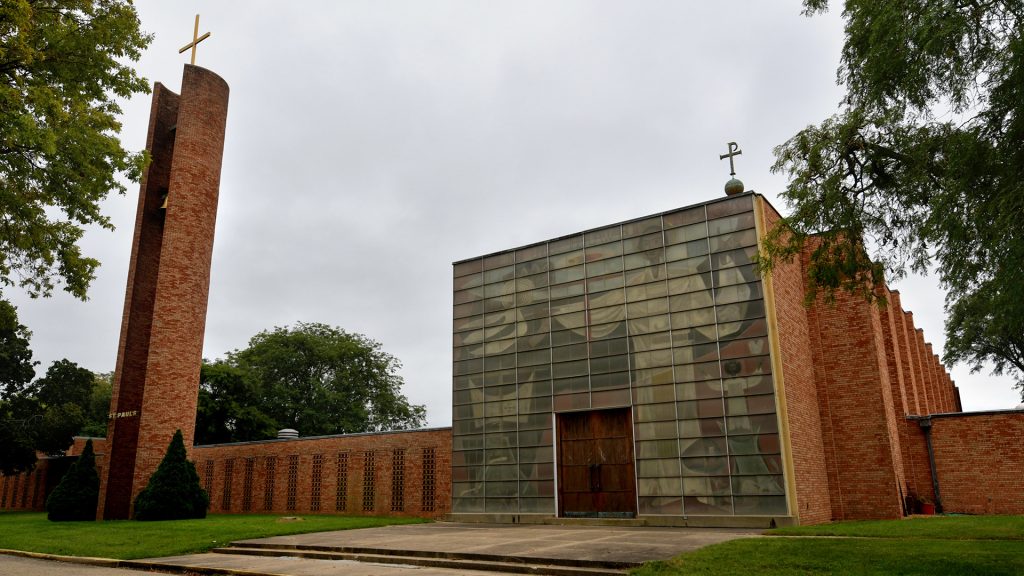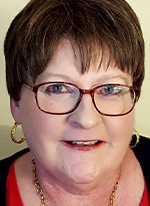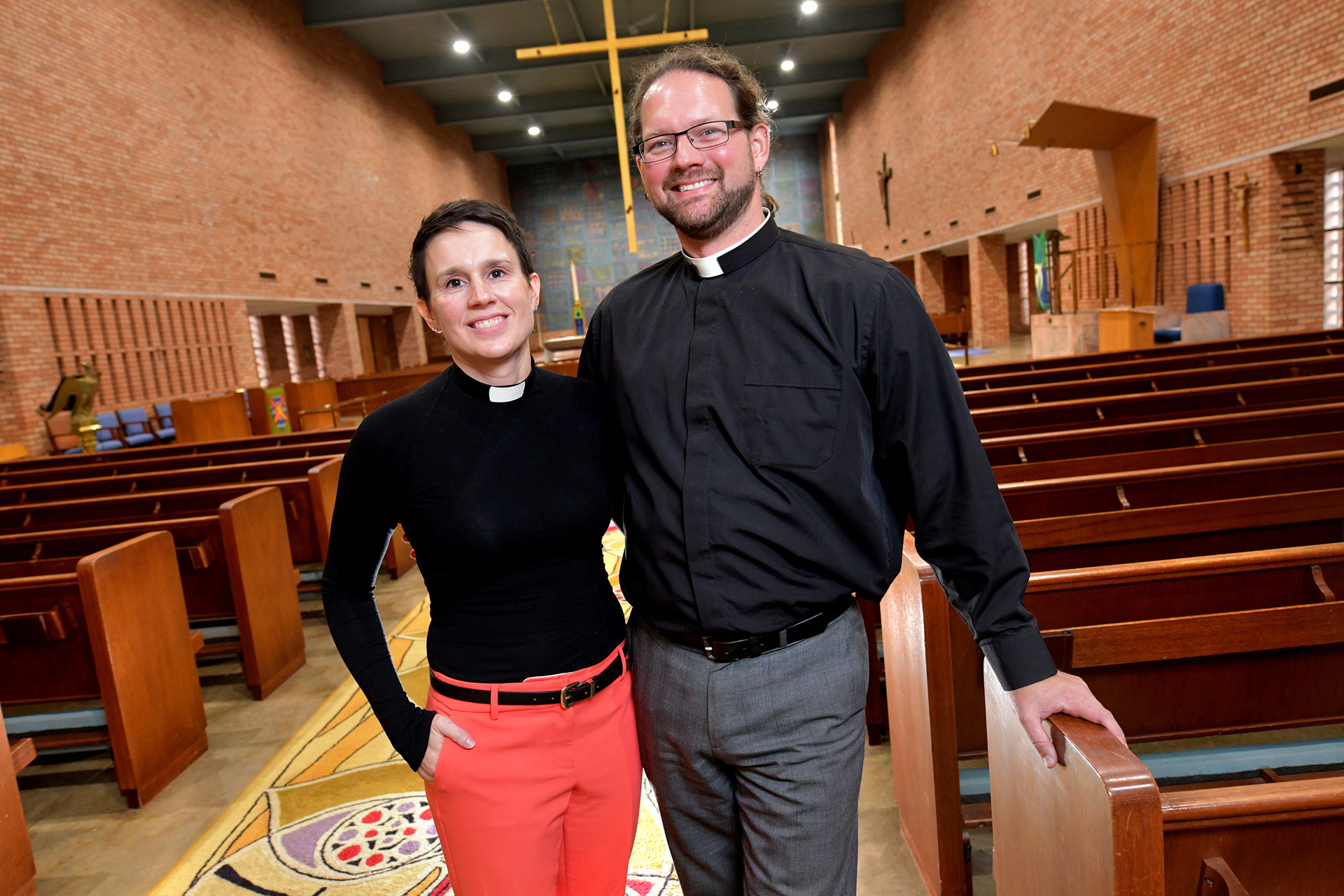After a painful break in the Episcopalian Church and a pandemic, St. Paul’s expands its mission and its outreach
With a church built to seat 500 but a post-pandemic attendance of 100 on any given Sunday, the co-rectors of St. Paul’s Episcopal Church see community partnerships that go beyond the traditional role of a church as a means of serving their neighbors.
Indeed, the church is utilizing its ample size to serve the community. Multiple classrooms on two levels became vacant when the Montessori School of Peoria moved out of St. Paul’s to another location. Looking to the church’s history of supporting the arts — the house of worship is an architectural gem in its own right — those empty classrooms are now serving as artist studios.
Meanwhile, during the pandemic, St. Paul’s kitchen was licensed and now is open to food entrepreneurs. One of the latter has opened Radish Kitchen, a restaurant near Bradley University.
It’s indicative of a necessary evolution for many religious institutions seeking to surmount their challenges and fulfill their missions through creative means that weren’t on anyone’s radar, once upon a time.
‘I just feel we need to be a part of the 21st century’
Once the cathedral of the Diocese of Quincy, St. Paul’s was one of only eight churches left in the diocese after a schism resulted in 15 churches leaving the Episcopal Church and joining the Anglican faith. Five years later, the remaining churches of the Diocese of Quincy merged into the Diocese of Chicago.
As it has since 1959, St. Paul’s continues to operate out of the sanctuary at 3601 N. North St. fronting War Memorial Drive, where it stands not only as a spiritual beacon but as one of central Illinois’ finest examples of Mid-Century Modern architecture, designed by St. Louis architect Frederick Dunn.
The Rev. Jenny Replogle and the Rev. Jonathan Thomas, co-rectors at St. Paul’s, arrived to lead the church eight years ago, just months after the diocesan merger.
By 2008, the Episcopal church at-large had ordained a gay bishop and a female bishop. “The Diocese of Quincy did not ordain women, allow same-sex marriage or queer people to be ordained,” said Replogle. “The bishop at the time did not allow any of that, whereas it had become common in the Episcopal Church. Over marriage equality and female ordination, he led the Diocese of Quincy to leave the Episcopal church.”
St. Paul’s chose to remain.

Christine Barrow, a lifelong member of St. Paul’s, recalls the split as painful for people on both sides of the divide.
“St. Paul’s is very inclusive and that’s certainly one of the reasons that I stayed… that and the ordination of women,” said Barrow. “I just feel we need to be part of the 21st century. I feel that’s what the church is all about, meeting the needs of people now.”
Barrows also is proud of St. Paul’s outreach program. “We are consistently looking outside ourselves to serve the community,” she said.
“We’re a fairly small church with some responsibility in a whole city,” said Thomas. “Our reach needs to come from the way we build partnerships with other churches, with like-minded non-profits or for-profit groups and community partners.
“What we really need to do is make sure that what we think is God’s work is happening in Peoria,” said Thomas, “and that we are in places where we can express what we think the good news is.”
After the split, “we became the only Episcopal parish in Peoria and we needed to figure out what that meant,” said Thomas.
“How do we love our neighbors here? St. Paul’s has a long tradition of feeding people through its food pantry,” he said. “A food pantry is great, but it’s mostly sustenance. It doesn’t help people move to a different life situation.”
St. Paul’s has partnered with Urban Acres in Peoria’s north valley, a business that raises fresh produce to sell or donate. The two entities have received a grant for Springboard Kitchen, a commissary kitchen at 616 Spring Street, for hosting healthy cooking classes for people in the neighborhood and launching small food businesses.
“If your dream is to sell something at the farmers market, to make extra money for your family, Springboard is a place to do that legally. It’s all about helping people get to the next level,” said Thomas.
God loves you, no exceptions
Thomas and Replogle are both Episcopal priests, a married couple and parents of son Rowan, 5, and daughter Asher, 2.
“Twenty percent of Episcopal clergy are married to each other, though it is uncommon for them to work together in the same parish,” said Replogle.
The couple ministers from the belief that God loves you, no exceptions.
“People are welcome at St. Paul’s at any point on their spiritual journey,” said Replogle. “It is a common story that people come here after they’ve been hurt by other churches.”
The Episcopal faith is steeped in ancient liturgy, which is a draw for disillusioned Christians of other faiths.
“Many people from the Catholic tradition come here because they love the liturgy but are either LGBTQ or have family members who are, or just know they don’t agree with the church’s stance, including the church’s stance on women’s reproductive rights or any number of things, including women’s ordination,” said Replogle.
Core tenets
The Episcopal faith has two essential sacraments for Christian life: baptism and eucharist. The other sacraments offered are confirmation, ordination, holy matrimony, reconciliation of a penitent and unction.
The Episcopal Church came out of the Anglican faith of England and still has a loose association with it.
“Every country gets its own branch of Anglicanism,” said Thomas. “In this country, after the American Revolution, the word Anglican wasn’t going to attract anybody. There were Americans who wanted to follow the traditions of the church, but nobody wanted to be Anglican anymore. It’s called the Episcopal church, which means ‘overseen by bishops.’”
“We put in structures where we elect our bishops,” said Replogle, “which is very American, as opposed to the way things were done in England.”
In the church’s spirit of partnerships, this year’s Easter vigil service was a partnership, “with two local churches that love liturgy, but don’t have enough worshippers for their own service, so we did it together,” said Replogle. “Their pastors were at the altar with us. It was great. I mean if we can’t celebrate the resurrection together …”
The rectors have brought special worship services to Peoria, including a Blue Christmas service, held on the longest night of the year. “This service is for people grieving or having memories of difficult things at the holidays and they’re surrounded by all the cheer of the holidays,” said Replogle. “It can be a really hard time. So, we want to have a space for that grief and honor all the feelings that people are having.”
Each October St. Paul’s has an infertility and pregnancy loss service. “We have a service that honors the struggles people have around childbearing.”





